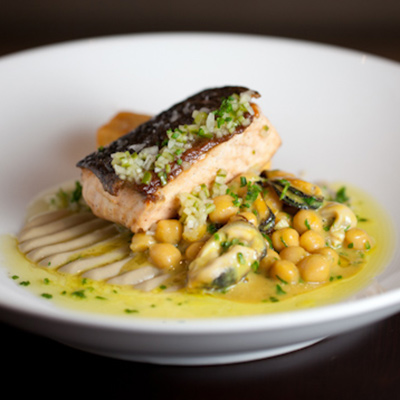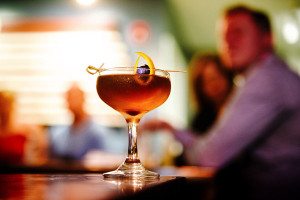Smooth Jazz and Skate Wing: 26 North Reviewed

Skate wing at 26 North | Photos courtesy of Mike Stollenwerk
The 1990s were a bad time for the American restaurant scene. We were, as an emerging culinary entity, in our first youth—like awful (if precocious) toddlers who’d gotten into Daddy’s special juice. All we did was copycat, put things in our mouths and stagger around blindly from impulse to impulse. Sure, we were occasionally cute. Occasionally (accidentally) brilliant. There were great restaurants that somehow managed to avoid all the foibles and excesses of the age, but on balance, almost everything was terrible all the time.
Consider a brief list of things restaurateurs and chefs thought were good ideas in the 1990s:
- Soft jazz
- Drop ceilings
- Rémoulade (everything had rémoulade on it)
- Glass plates
- Raspberry vinaigrette (really more of an ’80s thing, but depending on where you lived, also very much a ’90s thing)
- Lemongrass
- Frisée
- Those vintage French or Italian restaurant posters that uninspired college freshman with dreams of semesters in Paris or Rome hang in their dorm rooms. You know the ones. Le Chat Noir and things like that? Ugh.
- Tuna tacos
Fast-forward to 2016, and here is a brief list of things I encountered during a single lunch at Mike Stollenwerk’s new Old City BYO, 26 North:
- Soft Jazz
- Rémoulade
- Glass plates
- Frisée
- Those vintage restaurant posters that uninspired freshmen hang in their dorms.
- Tuna tacos
It was a terrible lunch. I hated it. Every single minute. The service was vacant and weirdly dismissive. The menu was like a powerful sedative. It could be used to put bears to sleep at the Zoo. Whatever they had on the radio sounded like it’d been composed by John Tesh’s less talented cousin—the kind of Muzak they play in the waiting room of Hell’s third-worst dentist’s office—and the space, in the fullness of daylight, looked like it’d been designed by someone who had never been inside an actual restaurant before and had been given only dog-eared 20-year-old issues of Gourmet as reference material.

Mike Stollenwerk at 26 North
Everything was served on frosted glass plates, and I can’t tell you how much that bugged me. There is no compelling reason (save, perhaps, some kind of terrible experiment in hipster-ish ironic detachment) to use glass plates in a restaurant. Absolutely everything that was wrong with American restaurants in the ’80s and ’90s can be summed up by the awful squeak of a dull knife skittering across a glass plate of cedar-planked salmon (not offered at lunch at 26 North, miraculously) and frisée salad with raspberry vinaigrette.
And as dull as the menu is, the only interesting thing about it was that everything I wanted (though “want” is kind of a strong word) was sold out, so rather than having the embarrassingly dated tuna tacos (with chipotle crema, avocado and flour tortillas) or a bowl of Menorcan fish soup (just because I like saying Menorcan), I had to order the crabcake sandwich with artichoke rémoulade (I should’ve added artichokes to that list, too) and hand-cut fries, because I certainly wasn’t going to order the shaved carrot salad with feta, raisins and vinaigrette (honey, not raspberry, but still) or the panzanella with smoked salmon, tomato and frisée.
It wasn’t a terrible crabcake sandwich, but it was a crabcake sandwich, and the crabcake sandwich is the safety dish of the seafood world. It succeeded in that it was a sandwich, cake-shaped and made of crab, but was otherwise entirely affectless and so boring that it could’ve been made of Nerf.
I drank a Boylan’s cola, played a couple rounds of Plants vs. Zombies on my phone, ate my sandwich, and got the hell out before whatever evil wizard had transported Stollenwerk back to a suburban Illinois Holiday Inn circa 1994 got a hold of me, too.
And then I went back for dinner a few days later, and a weird thing happened.
I loved it.
I’m serious. It was exactly the same place, except that in the soft glow of candles and warm Edison bulbs on exposed bricks, it felt completely different. It was exactly the same place, except that the glass plates had been replaced with understated white china, and the service was warm and funny, and the Devil’s elevator music was gone. And the menu? The menu was awesome, filled with a dozen weird little oddities and departures from the expected. Scallops with smoked duck breast and sour cherry. Salmon spiced like pastrami and served with a whole-grain mustard sauce. Frog’s legs with chili and garlic. Skate wing with truffled spaetzle, swimming in a parmesan broth, all beautifully composed in the shallow well of one of those perfect white plates.
Let me tell you a little something about Mike Stollenwerk. He’s the guy who used to run the line at Fish and Little Fish back in the day—excellent, boutique, almost jewel-box seafood restaurants in a city that, inexplicably, hasn’t been able to pull off a proper fish house in years. Fish was great. I might’ve liked Little Fish even better, especially in the summers, when the menu seemed to come with an added hit of salt air and that lazy, soporific feeling you get when you’ve given yourself half a case of sunstroke from drinking on the beach all day and everything you eat tastes like the best thing you’ve ever had.
He left those places a while ago. There were some weird years between then and now in which he was cooking in other restaurants around town, but the point is, Stollenwerk isn’t some rookie. He knows how to cook, and he knows how to run a kitchen. He knows restaurants, and this—THIS—is where it shows.
The ring-molded peeky-toe crab is beautifully simple—the perfect, delicate sweetness of lump crabmeat offset with fatty, slick avocado, then spiked with the eff-you bitterness of sharp winter citrus. The crown of fried shallot adds an odd woodiness that’s not unwelcome, a savory reminder that proper balance in a plate means one of each thing (sweet, bitter, savory), not 11, and that artistry is best expressed in restraint (a lesson I will steadfastly never learn).
Along with the bread service, my server brought salted butter, a bit of chimichurri (it was too oily, but still good), and a small portion of chickpeas, black olives, oil and rosemary that was so good, I would eat it with a spoon. Know how I know that? Because when no one was looking, I ate it all with a spoon.

Australian Barramundi at 26 North
On the scale of comforting foods, I consider chanterelle mushrooms sautéed in butter, sushi, and bagged Lay’s potato chips to be at the top of the list, but fish and potatoes together would be ranked pretty high. Fish and potatoes (better still, fish, clams and potatoes, all sharing the same hot tub of broth but not made into a soup) are like the food version of wearing a warm turtleneck sweater and staring pensively out to sea, and Stollenwerk gets that. His Australian barramundi is served with littleneck clams and potatoes in a celery broth livened up by bacon. He did a similar dish before with sea bass and a different broth, but this one is more refined. There’s a piperade for some spice and angry Basque brightness. A parsley gremolata for … something.
And then the monkfish.
The monkfish comes with grapes to which nothing has been done. Just green grapes, split in half. Do fish and grapes together sound gross to you? They’re not. There are walnuts scattered around the bottom of the plate, and their oiliness is a perfect counterpoint to the fish, which isn’t oily at all. Black beluga lentils sit in a puddle of sauce touched with vinegar (which is, yes, a vinaigrette of sorts, but not raspberry and, by itself, the single most delicious thing on a plate full of delicious things—the astringency of that faint vinegar echo on your tongue haunting and addictive) and studded with florets of curried and seared cauliflower. Everything about the dish is so calculated and yet so natural. It was amazing. No other word for it. When I was done, I wanted another. I would’ve eaten it all over again for dessert.
So what do I do with a place like this—a restaurant that I both hated like poison and loved with (almost equal) passion? How can I judge a single address that with some lights, a different Pandora station, some chickpeas and cauliflower, and a server who doesn’t act like she’s late for the bus, becomes a completely different restaurant?
Easy. Don’t go here for lunch. Forget that lunch even exists. Unless you’re really jonesing for a mediocre crabcake sandwich and some jazz flute—unless your grandma is in town and she’s afraid of all foods dreamed up after the first Clinton administration, or you’re on some kind of diet that only allows you to eat things that are beige—go pretty much anywhere else.
But absolutely come back for dinner.
2 stars – Come if you’re in the neighborhood.
26 North [Foobooz]


